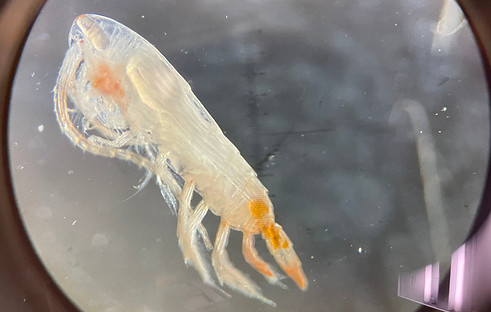top of page
Foraging Ecology of North Atlantic Right Whales in the Gulf of St. Lawrence
The North Atlantic Right Whale
Over the past decade, increased mortality due to vessel strikes and entanglements in fishing gear as well as decreased reproductive rates due to a declining food supply have made the situation dire for North Atlantic right whales (Eubalaena glacialis). In 2021, researchers estimated that only 340 North Atlantic right whales remained (North Atlantic Right Whale Consortium Report Card, 2022).
North Atlantic right whales feed in the northeast US and Atlantic Canada during the spring, summer, and early fall. They feed on rice-sized zooplankton called copepods. Largely due to climate change and changes in the distribution of copepods, right whales have been abandoning previously important foraging habitats, like the Bay of Fundy, in favor of more northern habitats, like the Gulf of St. Lawrence. Unfortunately, the latter is much more heavily trafficked and fished, increasing the risk these whales face when trying to find food (Davies & Brillant 2019).
There is still much to learn about this new right whale foraging habitat in the Gulf of St. Lawrence. Students and researchers in the Davies Lab at UNB have been sampling the oceanographic properties of this habitat for several years now, and they participate in right whale surveys with colleagues from the New England Aquarium, Canadian Whale Institute, Dalhousie University, and Fisheries & Oceans Canada (DFO).
Vertical Migration of Copepods & Vessel Strike Risk for Right Whales
The copepods that right whales feed on are known to vertically migrate in the water column; during the night, they swim up to feed on smaller zooplankton, and during the day, they retreat to depth to avoid being seen and eaten by larger predators.
Understanding the patterns of vertical migration could help us predict where in the water column right whales will be located during the day and night. If they are in shallower depths at night, this might increase their risk of vessel strike, especially in low-light conditions.
As part of my PhD research, I'll be analyzing oceanographic data from 2019 and future research cruises in the Gulf of St. Lawrence to determine how copepods are distributed in the water column at different times of day, when right whales are nearby. I hope that this information can be used to inform models of vessel strike risk for these endangered whales.
I'll also be estimating the concentrations of copepods and comparing them to other known foraging habitats, including the Bay of Fundy. One hypothesis is that the Gulf of St. Lawrence is actually not an optimal foraging habitat, although still better than other habitats that have experienced recent declines in copepods. By combining oceanographic sampling with data collected by the New England Aquarium during right whale surveys, I will be able to estimate if there are sufficient concentrations of copepods to support different demographic groups of whales that visit the Gulf of St. Lawrence in the summer.

To study plankton in the water column, we use a variety of oceanographic sensors. From left to right: an ocean glider, a cage with an optical plankton counter, and a multinet.
The ocean glider autonomously profiles the water column, collecting data on temperature, salinity, and depth, as well as listening for whale calls using a hydrophone. It also has an echosounder that uses sonar to measure the amount of plankton in the water.
The cage is deployed vertically behind the research vessel. As it descends, the optical plankton counter uses a light beam to detect the abundance and size of plankton in the water column. Meanwhile, another sensor records temperature, salinity, and depth.
The multinet is comprised of a series of nets that are pre-programmed to open and close at designated depths. This way, we can collect samples and examine the abundance and species composition of plankton at specific depths.
Last updated: January 2021
Come back in the future for more updates on this research project!
*All research on right whales is conducted under necessary research permits through the Canadian government and approval from UNBSJ's Animal Care Committee.*
bottom of page

